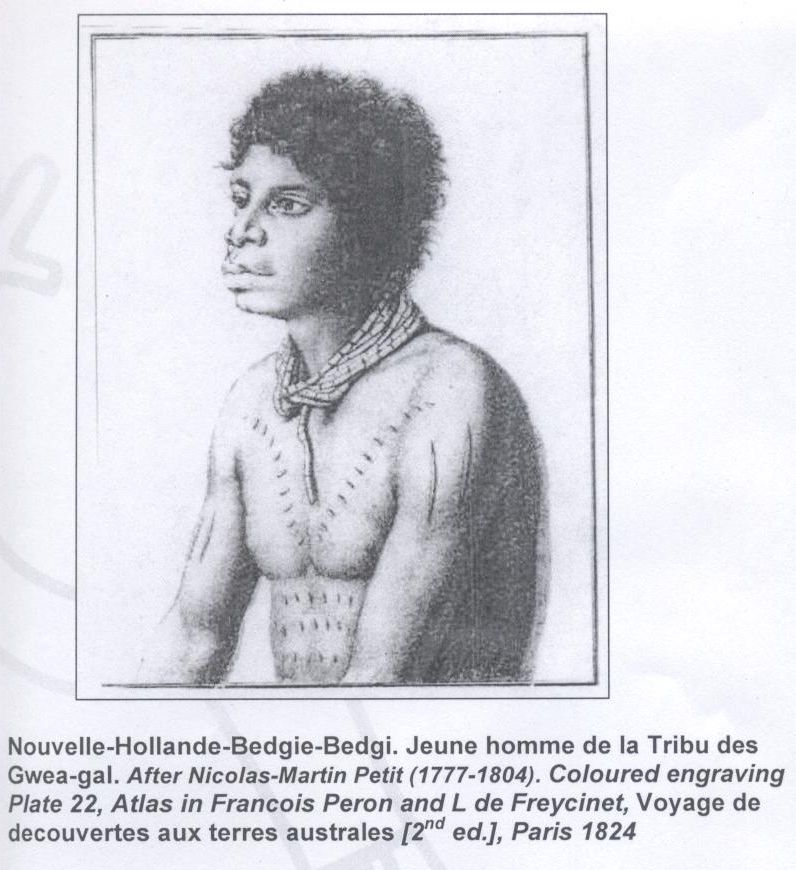
Bidgee Bidgee (c1787-c 1836)[1] First recorded as the five year old attending the funeral of his step-brother, Ballooderry, in the grounds of Government House. [2] His name translates as ‘river flats’ which is not unusual for someone born at what we now call ‘Meadowbank.’ He shared the same father as Balloodery, namely Maugoran, but his mother was Tadyera.[3]
In 1804 he was injured in a fight with another young man, Mirouth.[4] He then becomes a sailor, engaging largely in sealing and whaling. Like his fellow sailors he swore, smoked and drank grog.[5]
In 1811 there is a court case involving an Aboriginal man seeking to recover unpaid wages. [6]
In 1814 an Aboriginal who quit sealing and returned to live a traditional life was quoted as saying:
“Will you keep me company: or will any white man or woman keep me company? White women will marry white men, but no white woman will have me; then why wish me to keep away from my own people, when no other will look upon me. Even Aboriginal children reared among Europeans have abandoned European customs for their own after being treated not as equals, but as creatures not possibly to be associated with.”[7]
It is probably from this time that a long time Parramatta resident George Macarthur remembered:
“I knew Harry and his contemporary Bidgee Bidgee personally and intimately, for as boys we were allowed to go out with them on excursion to hunt opossums and bandicoots. Acquired an extensive knowledge of their vocabulary.”[8]
He was engaged as a tracker by Governor Macquarie and rewarded by being appointed Chief of the Kissing Point tribe[9] and receiving (amongst other things) a boat.[10] A grant of land at Kissing Point was initiated but not completed in 1816.[11] In 1828 he is quoted as a frequent visitor to James Squire’s home at Ryde and saying that he wished to be buried, when he died, next to Bennelong on Squire’s property.[12]
In 1829 his adopted daughter was admitted into the Black Town Native Institute, this “little native girl … has never been able either to speak or walk. She has pined away of a lingering disease in all probability received from her parents”[13] which was probably venereal disease.
There is a possibility that Bidgee Bidgee was buried in modern day Abbotsford.[14]
[1] His portrait appears in F Peron Voyage de decouvertes aux terres Australes (Paris, 1811) as Bedgi-Bedgi jeune hommede la tribu des Gwea-gal as drawn by
Nicolas-Martin Petit (1777-1804) amd also in G Karskens The Colony (Sydney, 2009) p 430
[2] D CollinsAn account of the English colony in New South Wales (Sydney, 1975) Vol 2, p 501
[9] AO NSW 4/1798 pp 45-7; AO NSW 4/1734 pp 149-68 quoted in R Hawkins Aboriginal Life in the Blue Gum High Forest (unpublished manuscript, 2011) p 31; J
Brook & J L Kohen The Parramatta Native Institution and the Blacktown: A History (Kensington, 1991) pp 23, 25, 31
[10] Sydney Gazette 6 June 1818; K V Smith Wallumedegal: An Aboriginal History of Ryde (Ryde, 2005) p 19
